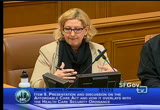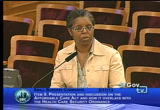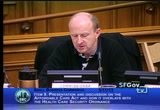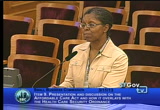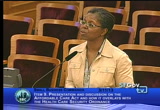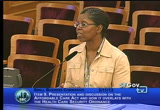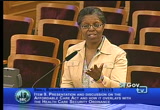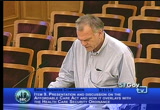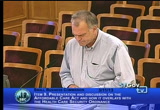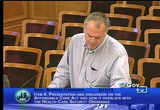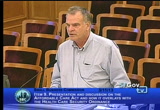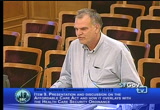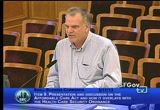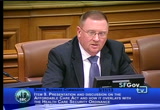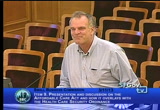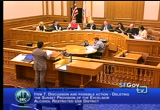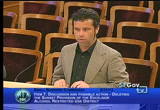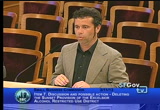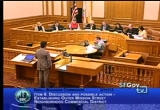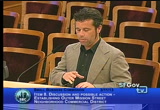tv [untitled] March 18, 2013 4:30am-5:00am PDT
4:30 am
what constitutes an eligible employee. for the purposes of the affordable care act it's any employee that work at least 30 hours a week. after 90 day as an employee of that particular employer. for the health care security ordinance, it is 8 hours a week after 90 days of working with that employer. and so there are differences, as i said, in what the definition of "employer" is and certainly the definition of "employee." and trying to ensure that we really have a matrix that is available for our businesses, small, medium and large. so that they understand when an employee may fall under the health care security ordinance versus when an employee may fall under the affordable care act and
4:31 am
employer also. >> director dick-endrizzi. >> so i think conceptually, just to -- since i don't know the affordable care act law in great detail, and i think some of the conversations that businesses tend to have is under the affordable care act, we have what are sort of the rules and regs for businesses that have 50 or more full-time employees but also under that in taking a look at the affordable care act did sort of establish the exchange program. >> so i want to make sure when we talk about affordable care act it's relates to employer and employee size, how does the affordable care act -- how do i want to say this? a part from the exchange program, does at fordable care act give any sort of governance or guidance
4:32 am
or direction around businesses under that 50 full-time employees in terms of what the rules and regs are? >> the on the provision as i indicated small businesses, 49 or below are not required to have coverage. and as i indicated around incentivizing small businesses, 0-25, but offering them tax credits to make the cost of coverage from the employer's perspective more affordable. >> okay, great, thank you. >> commissioner o'brien. >> would you say in your opinion, that there is a lot of
4:33 am
overlap between the two programs? i mean i'm trying to see if the health care act is left in case, which is obviously going to be the place and the other option was taken out, the health security, would that leave a wide slot or section of people that are vulnerable and not covered that wouldn't fall under the umbrella of the affordable care act? i'm trying to -- it's extremely complicated and we're finding out it's going to take a lot of work to research how these programs work on their own first, and then between each other. and i was wondering would it be easier to amend one of them to sort of just be adjusted to fill in the gaps of the care act that doesn't cover it? so that it would be easish to manage the whole thing?
4:34 am
would time be sent better trying to engineer it that way, then trying to evolve both of them and keep reconciling both of them with each other? >> that is a great question, commissioner o'brien and let me respond by saying that the affordable care act does waive large numbers of employees without health insurance. >> can you give me an example? >> as i was indicating, it only requires that an employer with 50 or more employees and the employees that are full-time equivalents, so the employees working 30 hours an week, that that employer pay a penalty for not providing coverage. it does not apply to employers with 0-49 full-time
4:35 am
equivalent employee or for an employer that may have an employee that maybe the employer has 50 plus full-time equivalent employees, but it also has a number of part-time employees that may only work 20 hours a week or 25 hours a week. so that employer is not required to pay a penalty if they do not provide coverage. now, that is from the employer's perspective. now but from the individual's perspective, as i was indicating an individual on their own is required to actually have health insurance irrespective of what their employer may or may not do. let's take the example an employer who has 50 or more full-time equivalent employees, but they have two or three part-time employees that work 20 hours a week?
4:36 am
those employees are able to go either into cover california or based on their income they may be eligible for medicaid. they will have met the individual mandate. the employer is not required to provide coverage because they are not a full-time employee and there is no penalty and the overall goal from the federal government's perspective has been met and that employee is now covered and that there is some way that coverage is subsidized either fully, through medicaid or partially, through the exchange, depending upon the person's income. >> thank you.
4:37 am
>> commissioner dwight? >> what is the verification protocol for determining whether someone complies to have insurance? >> so all health plans will be required to provide documentation to individuals who receive health insurance. and that documentation and it's not determined whether it's not it will be in paper form or electronic form, but it will be through someone's taxes. and so that is how the penalty is assessed through the taxes. so an individual will be able to document through their taxes, ifs it's liquor electronic it will be a check box and if it's paper, it's not the most efficient, but that will be the mechanism.
4:38 am
the penalty is graduated and goes up to shy of $400 in 2015 and then goes to $700 in 2016 and then there are annual increases above and beyond that. >> it's through state and federal income taxes that the verification process? >> federal. >> that it will occur? >> yes. >> okay. >> commissioner ortiz-cartagena? >> i had a question. if an employer like a restaurant has hra accounts and i mentioned hra accounts do not qualify under the federal guidelines, correct? if an employee opts to go through the subsidized exchange program through an individual, would that mean you opt them out of the hra plan for the employer? >> that is one of the questions that a number of people have asked us. so we are getting legal direction on that question. so if i understand your question, someone has actually gotten health insurance and so if they
4:39 am
have gotten health insurance on their own, what obligation, if any, is there by the employer? >> correct. >> right. that is a question that we are proposing that the city attorney look at from a legal perspective and that will help drive the policy conversation and discussion. >> thank you. >> any other commissioner comments? >> matt or scott, anything that you would like to add? >> i was here for questions -- if there is nothing specific for me, i don't have additional comments. >> okay, great. >> so scott? >>well, i think tangerine's presentation was tremendous. it was very, very clear and
4:40 am
concise and thank you for that. i wish every small business person could hear that. i am going to start -- this is very, very confusing stuff. and it's over 2,000 pages of material, and we're looking for regulations, which all haven't been drawn up yet. so it's definitely a work in progress. it's got to come together for the exchanges by october 1st. so they are really on a fast-track at this point. but if you will bear with me i will read an ris ruling as far as shared responsibility and it kind of illustrates what kind of the problem is. and this was their discussion on the use of payroll periods, and it says, "for payroll periods that are one week, two weeks or semimonthly in duration, an employer is permitted to treat as a measurement period a period that end on the last day of the payroll period, proceeding the
4:41 am
parol period that includes date that would otherwise be the last date of the measurement period, provided that the measurement period begins on the first day of the payroll period that includes the date that would otherwise be the first day of the measurement period." [ laughter ] >> have you heard of monty python? >> part of the problem is -- while they are coming up with new regulations, when the regulations come out, there can still be a lot of confusion out there. what i would like to do, and it's not going to be really orderly, but kind of touch on some of the areas that may be of interest to the small business community. just as far as the tax credit, in our survey, 74% of the businesss did not know that the tax credit was there. there really is an education that needs to go on. a lot of people will argue that 50,000 average per employee is so low
4:42 am
that a lot of businesses aren't going to qualify. i might also point out that currently for the current year as tangerine said in 2013 it will be 50%, but currently the credit that is available and has been available for a few years is 35%. so that is the current credit. and i think one of the things that you have until -- anybody knows if it's march 15 to file for that? >> yes. >> march 15th, you need to file for it for the year. the other thing is, as was mentioned, how is an individual going to comply? and it's going to be through the taxes that they pay. but i thought you might find it interesting to find out -- now this is for businesss with 50 or more employees. what does the need to do? what the business need to do is provide
4:43 am
the name, address, tax information and whether it offers full-time or part-time employees. the monthly premium of the lowest cost option, the employer's share of the cost coverage, the number of full-time employees in each month of the year, the name, address and social security number of each employee and dependents and any other information required. that is a requirement for business with 50 or more employees. as i understand it, if it's less than 50, and correct me if i'm wrong, if it's less than 50 i don't think the employer has too provide that information. is that accurate? >> yes. >> just so you know. there is something else that you will hear about and there is a lot of confusion on this. there is a provision that talks about grand father clauses and the president mentioned this frequently and said if you like
4:44 am
your coverage, you can keep, it otherwise, you can pick up -- -- take the new coverage s available. there is minimum criteria, but there is confusion about what is grandfathered and what isn't grandfathered? and basically, if you keep your coverage, and it meets the requirement -- you don't change the coverage. for example, you cannot significantly reduce or cut benefits. you cannot raise co-insurance charges. you cannot significantly raise the compayment charges. you cannot significantly raise deductibles.
4:45 am
big question out there and i don't have an an increase, but trying to find out is there any way for an employer to provide money to the employee to buy their individual coverage? and you just heard that hra are not a viable option. when i asked about 125 and cafeteria plans, i'm getting mixed answers and i'm not sure that the irs has determined what exactly the answer is. maybe you know more than i do, but if it is going to be able to get that money to the employee on a pre-tax basis, that could have significant ramifications to an employer on whether they provide insurance or they don't provide insurance. so it's out there, and when you look at the subsidies, especially if you are under $50,000 in income,
4:46 am
the subsidies are really, really significant for the employee and their dependents. so that is something that have i not heard a definitive answer on that and all the people that i have talked to say it's not out there definitely. the other thing talking about deductibles and maximum deductibles for an individual is $2,000 and $4,000. now i have heard, i have read that a lot of the individual plans have higher deductibles. so i don't know whether that is going to be an issue. but those are the maximums under the affordable care act. what really at the end of the day is important here is all the things that we're talking about right here are significant, but at the end of the day, if the affordable care act is going to succeed, it's
4:47 am
got to lower the cost. that is absolute. because we have a system that is just crazy. it's $2.67 trillion, i think is what it was in 2011. it's higher than any other -- at least 50%, i believe it is higher than any other industrial country and we have a system that when you look at the absolute result, if you have got a lot of money, it's the best system in the world. but you look at the results and you look at infant mortality and you look at longevity and when we're spending all of this money the result would be better, but we're down in the bottom in an awful lot of those areas. so what i think we need to do is drive the costs down, but we can't forget that we have to drive the quality up. a program that is in place right now, most of it is paid by procedures, instead of paid by outcomes. that makes no sense at all. we have got to get to a program
4:48 am
that pay for outcome s and they working on unbundling and reducing the costs. if we don't get a hold of the cost driver we're going to have some real problems and being successful in the future. >> any questions for scott? >> thank you very much. >> thank you. >> one question. >> not for scott. i think it's maybe for matt or tangerine. if you are under 50 employees, in san francisco, is the health care security ordinance still in place or does the affordable act? >> pending any legislative changes at the local level,
4:49 am
those would still be in place for those businesses with between 20 and 49 employees. and those folks would be just subject to the local ordinance, the way that they have been currently. >> okay. >> great, thank you. >> let's open up to public comment. do we have public comment on item no. 9? seeing none, public comment is now closed. commissioners, this is a discussion item, but one of the things i was thinking about maybe getting a task force, with scott and let's talk about -- because it is confusing. and i really appreciate -- i really want to say thank you tangerine, because you really made me understand it a little bit better. still confusing, but i understand it a little bit better. >> very good. >> and scott, thank you again.
4:50 am
because this is going to affect small business not only in san francisco, but throughout the state of california. and like you said, i know when you start doing -- i did my taxes already this year and it asks you already this year, do you have a health care plan right now? director dick-endrizzi? >> well, president adams, i think that something like an advisory board to kind of bounce off sounds like a really good idea as we move forward. it makes me think of proposition e and where we had some the gross receipts, where we had a different range of small businesses to be able to work through that. so i think that is a great idea. maybe another sort of thing that we can also think about is scott read through the reporting requirements for businesses that have 50 or more
4:51 am
full-time employees, and you know, that is always a complaint that we hear, is the amount of reporting requirements. and you know, with the health care security ordinance and other things, and maybe we can think about how best to line those up, as we develop things. so that we can make -- we're not having two different types of reporting requirements, especially for the 50 or more full-time employee businesses so we try to line it up and simplify it, as much as possible. >> great. >> so i will take your -- >> commissioner dooley? >> i just wanted to comment about scott's comments about how small business might be able to work on participating and driving these costs down and i wondered if you had anything in particular in mind? or any way that we could be
4:52 am
working together on that? because i understand that that is -- we get very little bit of in a sense from what we pay. >> the reason organization is made up of major employees called the pacific business group on health and this is their driving issue. and i would strongly suggest you work with the pacific business group on health and i also suggest you work with michael wineberg, who is with bay area council. they are spending a lot of time on this stuff, and they are very, very knowledgeable. there is a program out there, for those of you who get my emails, i will test you here, did you read the "choosing wisely" piece i put out? there is now an effort with the
4:53 am
pacific group that is providing information to employees to tell them how they can reduce their costs and improve their quality and that is available. i will send it over to regina tomorrow. that is out there. and we have got to do our part to get information in the hands of our employees to try to bring these cost down. >> thank you thank you, scott. any other commissioner comments? thank you everybody. thank you, tangerine, again. that was a very good presentation. thank you, scott. okay. would you like to go back to item no. 7? >> yes. commissioners, item no. 7 discussion and possible action to make recommendations to the board of supervisors on board of supervisors file no. 130018, planning code, deleting the sunset provision of the excelsior alcohol restricted use district. presentation by jeremy pollack, legislative aid to supervisor
4:54 am
john avalos in your binder a briefing document and maps of the alcohol restricted use district and the planning department had it on two separate maps, and then you have the digest along with the legislation. and thank you, jeremy. >> good evening commissioners, i apologize for not being here when you first called the item. i was distracted by some constituents that we had and supervisor avalos sends his regrets he is celebrating his birthday at the southern pacific brewery right now, so he send me instead. the excelsior alcohol restricted use district was created in 200by then supervisor sandoval and apply as to off-site liquor licenses and doesn't apply to restaurant, bars and those sorts of establish thes and extend agency long the mission street corridor from 280 to the daly city border. it was originally established to expire after five years. we're not exactly sure why it was given that sunset date, but in talking tot neighborhood
4:55 am
everybody seems to think it's working well and the air is more than well-served with liquor store and places to buy alcohol. so the neighborhood would like to continue the restriction. and that discussion has led us to the next item on the generationeding the outer commission neighborhood commercial district and the plan is to sort of absorb the district control and give more flexibility in the zoning of the area. because of the upcoming expiration of the alcohol restricted use district, this is a stop-gap measure to make sure it at the take us longer to establish the neighborhood commercial district.
4:56 am
>> any commissioner comments? pretty straightforward. we actually talked about this at your legislative -- we'll talk about that after public comment. do we have public comment on item no. 7? seeing none, public comment is closed. commissioners? any comments? >> it seems very straightforward to me. and i move we approve this. >> i think when we eliminated sunset dates it will go on forever, until? >> the law change? >> that is correct. >> we voted to approve. >> we recommended approval. so we have a motion by commissioner dooley. do we have a second? >> i will second. >> want to do a roll call vote. >> on that motion, commissioner adams?
4:57 am
>> aye. >> commissioner dooley? >> yes. >> commissioner dwight? >> aye. >> commissioner o'brien? >> yes. >> commissioner ortiz-cartagena? >> aye. >> commissioner white? >> yes. >> commissioner yee riley? >> aye. >> commissioners that motion passes 7-0. >> great. next item, please. >> commissioners, you are now on item no. 8. discussion and possible action to make recommendations to the board of supervisors on board of supervisors file no. 1300084, planning code zoning map establishing outer mission street neighborhood commercial district and we have a presentation by jeremy pollack. legislative aid to supervisor john avalos. in your packet is the briefing documents, the legislative digest along with a highlighted version of the ordinance that was sent to you last week with any changes and the only additional changes that i heard back from the excelsior action group aeg and they are in
4:58 am
support of the legislation. >> welcome back. >> thank you. so like i said, this neighborhood commercial district proposal came out of our discussion about the alcohol restricted use district. and it was -- to update the planning code for this area, and in discussion with the neighborhood and merchant groups it felt like it brought legitimacy to the outer mission. they are excited to have outer mission on the map of the planning code and be at the same level of the named neighborhood commercial districts. so we have been in the process of discussing with a number of neighborhood groups about what specific controls they would like to see? and as i mentioned before, it absorbs the alcohol restricted use district, so that would become part this neighborhood commercial district and it also continue their restriction on fringe financial service or check-cashing facilities in the area. let's see, it also preserves the ground floor active youth
4:59 am
height ordinance, so for parcels zoned for 40-50', you are aloud an additional 5' of height for the ground floor, and that is to encourage people to build 15' ground floors instead of 10', so you get a much more attractive ground space. that is in existing designing carried over into the neighborhood commercial district. the parking controls, it takes away the parking minimum parking requirements and still allows the same park, but it's not required, which we felt was appropriate for this transit-rich area. and then i have -- i don't know if i can show on the overhead, but a map that will show the extent of it. so essentially it extends up here would be that is basically mission street south 280 and
68 Views
IN COLLECTIONS
SFGTV: San Francisco Government Television Television Archive
Television Archive  Television Archive News Search Service
Television Archive News Search Service 
Uploaded by TV Archive on

 Live Music Archive
Live Music Archive Librivox Free Audio
Librivox Free Audio Metropolitan Museum
Metropolitan Museum Cleveland Museum of Art
Cleveland Museum of Art Internet Arcade
Internet Arcade Console Living Room
Console Living Room Books to Borrow
Books to Borrow Open Library
Open Library TV News
TV News Understanding 9/11
Understanding 9/11

